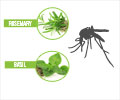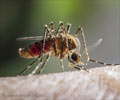Highlights
- The bacterium Wolbachia spreads by manipulating the host’s reproduction.
- This bacterium uses the cytoplasmic incompatibility or CI mechanism in which sperm of infected males are made lethal to the eggs of uninfected females, thereby sterilizing the uninfected females.
- A single pair of Wolbachia genes that produce this CI effect only when working together has been discovered.
The two universities have applied for a patent to use these genes to genetically engineer either the bacterial parasite or the insects themselves to produce more effective methods for controlling the spread of insect-borne diseases like dengue and Zika and for reducing the ravages of agricultural pests.
"We've known for decades that one of the secrets to Wolbachia's success is that it interferes with host reproduction in order to spread itself through females. But how the bacterium did it was a major mystery for the field," said Associate Professor of Biological Sciences Seth Bordenstein, who headed the Vanderbilt contingent.
"Now we know the genes that give it this capability." Bordenstein added.
Zika and dengue is considered to be the most rapidly spreading mosquito-borne viral disease in the world.
Since the results have been promising, the scientists have been looking for ways to determine the most effective way to use Wolbachia to control Zika and dengue.
Wolbachia uses a process called "cytoplasmic incompatibility" or CI to manipulate the host's reproduction.
In this process, the sperm of infected males are rendered lethal to the eggs of uninfected females.
The researchers have identified a single pair of Wolbachia genes that produce this effect only when working together. The CI genes are located in a portion of the Wolbachia genome called the eukaryotic association module, which contains genes that the bacterium appears to use to interact with its host.
When an infected male mates with an uninfected female, only few of the eggs hatch. But when an infected male mates with an infected female or when an uninfected male mates with an infected female, they produce the same number of offspring as when uninfected males and females mate.
The number of infected females produced in each generation is maximized as a result of this, which is beneficial to Wolbachia because it is only passed down through the maternal line.
"This is an extremely effective strategy. Under ideal conditions it allows Wolbachia to infect an entire host population within a few generations or years," said Bordenstein.
How Wolbachia Can Curb Spread of Viruses
"There are two basic approaches for using Wolbachia to eliminate or curb the spread of a viruses like dengue and Zika," said Bordenstein.
The first approach is a stable approach, called population replacement. It involves introducing Wolbachia to a population od both males and females infected mosquitoes, so they spread the bacteria on their own until they eventually replace the resident population.
The risk of dengue and Zika transmission drops as they spread because Wolbachia prevents these disease viruses from replicating.
The second approach, called population suppression, is to introduce copious numbers of infected males. Because the uninfected females that mate with infected males fail to reproduce, this reduces the size of the target population.
The first approach is slow but steady and will eventually lead to the reduction or virtual elimination of disease transmission. Though the second approach is faster, the insect population can rebound so it must be administered repeatedly.
The Vanderbilt researchers found that using genetic engineering to insert the Wolbachia CI genes into infected insects can strengthen the incompatibility effect and so significantly decrease the hatch rate of uninfected females who mate with infected males. As a result, it may increase the rate at which the bacterium spreads.
The next step in the research is to search for the genes in infected females that counteract CI, which rescue their eggs and allow them to hatch normally.
This achievement is described in the journal Nature in a paper titled "Prophage WO Genes Recapitulate and Enhance Wolbachia-induced Cytoplasmic Incompatibility" and in a companion article titled "A Wolbachia deubiquitylating enzyme induces cytoplasmic incompatibility" in Nature Microbiology.
Reference
- Seth Bordenstein et al.Prophage WO Genes Recapitulate and Enhance Wolbachia-induced Cytoplasmic Incompatibility. Nature; (2017)
- Seth Bordenstein et al.A Wolbachia deubiquitylating enzyme induces cytoplasmic incompatibility. Nature Microbiology; (2017)
Source-Medindia










